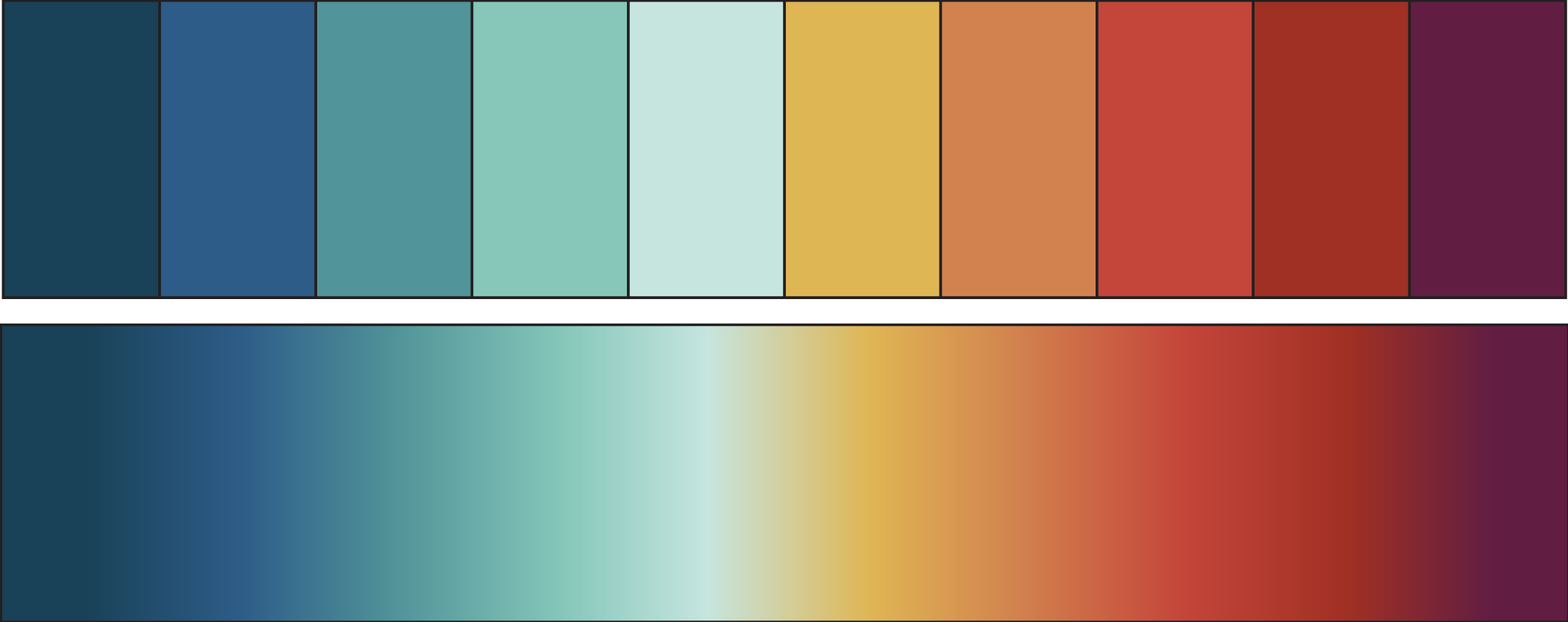Color Palettes
Add this file to your Adobe Illustrator Swatches folder to easily access these palettes in Adobe.
Kori’s Colormap
Kori created a lovely color scheme that has been approved by Joel. A PNG sample of the colors is included in the below figure and the RGB color values follow it in a table. When creating a figure in Adobe Illustrator, I recommend creating a new color swatch with these colors. Just ensure that the colors are defined as process colors, not spot colors. Spot colors give a weird gradient with grey in between the colors. The yellow color should not be used by itself when possible.

Color swatch and gradient of Kori’s color scheme. This image was created in Adobe Illustrator using the RGB values given in the below table.
| Color 1 | Color 2 | Color 3 | Color 4 | Color 5 | Color 6 | Color 7 | Color 8 | Color 9 | Color 10 | |
|---|---|---|---|---|---|---|---|---|---|---|
| R | 25 | 45 | 81 | 134 | 198 | 223 | 210 | 196 | 160 | 98 |
| G | 65 | 92 | 148 | 199 | 229 | 182 | 130 | 69 | 48 | 30 |
| B | 87 | 136 | 153 | 186 | 223 | 84 | 78 | 58 | 35 | 66 |
Colorblind Versions
For a person who is colorblind, these colors are not going to be quite the same. Because 1 in 20 people are colorblind in some way, it is important to make sure our generated figures are distinguishable for those with colorblindness. Using this website by David Nichols, I have simulated a snapshot of how someone with protanopia, deuteranopia, tritanopia, or deuteranomaly (Dtnm.) would see the above color palette. Protanopia is the lack of red cones in the eye, so the person cannot see the color red. Deuteranopia and tritanopia are likewise the lack of green and blue cones respectively. Deuteranomaly is a reduced form of deuteranopia, where the person has reduced sensitivity but not complete blindness to the green region of the spectrum. About 8% percent of people assigned male at birth and 0.5% of people assigned female at birth of European ancestry inherit some form of red-green colour blindness (protanopia, deuteranopia, deuteranomaly). Additionally, color blindness can sometimes be acquired due to diseases such as macular degeneration, glaucoma, diabetes mellitus, or Alzheimer disease. Acquired colorblindness is typically tritanopic (blue-yellow colorblindness).1
 |  |
A Basic Hot/Cold Palette

Color swatch and gradient of a hot/cold color scheme. This image was created in Adobe Illustrator using the RGB values given in the below table.
| Color 1 | Color 2 | Color 3 | Color 4 | Color 5 | Color 6 | Color 7 | Color 8 | Color 9 | Color 10 | Color 11 | |
|---|---|---|---|---|---|---|---|---|---|---|---|
| R | 165 | 215 | 244 | 253 | 254 | 255 | 224 | 171 | 116 | 69 | 49 |
| G | 0 | 48 | 109 | 174 | 224 | 255 | 243 | 217 | 173 | 117 | 54 |
| B | 38 | 39 | 67 | 97 | 144 | 191 | 248 | 233 | 209 | 180 | 149 |
Britannica, T. Editors of Encyclopaedia. “colour blindness.” Encyclopedia Britannica ↩
APPENDIX
appendix